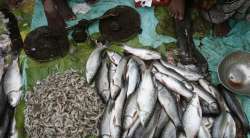Indian scientists develop method to convert fish-bio waste into green energy
The scales of fish has the potential of becoming an instant source of green energy in future. A team of researchers at Jadavpur University in Kolkata has developed a biodegradable energy harvester from raw

The scales of fish has the potential of becoming an instant source of green energy in future.
A team of researchers at Jadavpur University in Kolkata has developed a biodegradable energy harvester from raw fish scales that could be tapped as a sustainable green energy source for next generation self-powered implantable medical devices.
It also has the potential for personal portable electronics with reduced e-waste elements said the researchers.
Fish scales -- a by-product that is usually thrown away -- contain collagen fibres that possess a piezoelectric property, which means that an electric charge is generated in them in response to mechanical stress.
The researchers have synthesised flexible bio-piezoelectric nanogenerator (BPNG) from this bio-waste.
Assistant Professor at Organic Nano-Piezoelectric Device Laboratory, Dipankar Mandal explained: "We collected bio-waste in the form of hard, raw fish scales from a fish processing market, and then used a demineralization process to make them transparent and flexible."
"We were able to make a bio-piezoelectric nanogenerator (or energy harvester) with electrodes on both sides, and then laminated them," said Mandal from the Department of Physics, at Jadavpur University.
The recycling of the fish by-products into the BPNG via one step process is a promising solution for the development of value-added products and also to reduce the e-waste.
The nanogenerator also scavenges several types of ambient mechanical energies such as body movements, machine and sound vibrations, and wind flow which are abundant in living environment, and even repeated tapping with a finger.
Repeatedly touching the BPNG with a finger can turn on more than 50 blue LEDs.
The team's work is the first known demonstration of the direct piezoelectric effect of fish scales from electricity generated by a bio-piezoelectric nanogenerator under mechanical stimuli -- without the need for any post-electrical poling treatments.
The group's work could potentially be used in transparent electronics, biocompatible and biodegradable electronics, edible electronics.
It can also be used in self-powered implantable medical devices, surgeries, e-healthcare monitoring, as well as in vitro and in vivo diagnostics, apart from its myriad uses for portable electronics.
"In the future, our goal is to implant a bio-piezoelectric nanogenerator into a heart for pacemaker devices, where it will continuously generate power from heartbeats for the device's operation," Mandal said.
"It will then degrade when no longer needed. Since heart tissue is also composed of collagen, our bio-piezoelectric nanogenerator is expected to be very compatible with the heart."
Disposal of the fish bio-waste increases environmental pollution.
The study was published in the journal Applied Physics Letters in September and is co-authored by SK Ghosh.
(With agency input)